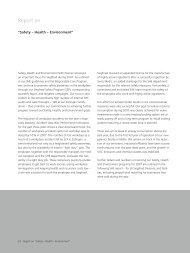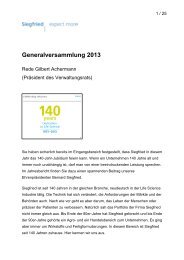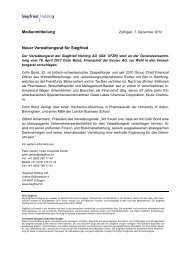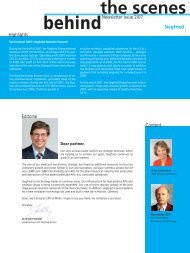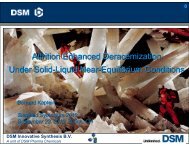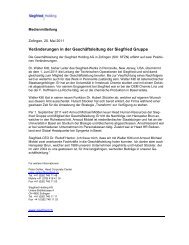Siegfried Annual Report 2009
Siegfried Annual Report 2009
Siegfried Annual Report 2009
Create successful ePaper yourself
Turn your PDF publications into a flip-book with our unique Google optimized e-Paper software.
of discounted future cash flows. Various criteria are applied<br />
to determine if there is objective evidence of an impairment<br />
loss. These criteria include significant financial difficulty of<br />
the issuer, a breach of contract, danger of bankruptcy, disappearance<br />
of an active market, etc. In the case of equity<br />
investments classified as available-for-sale, a significant or<br />
prolonged decline in the fair value of the security below its<br />
cost is evidence that the assets are impaired.<br />
Inventories Inventories are carried in the Balance Sheet at<br />
the lower of acquisition/production costs and net realizable<br />
value. Production costs comprise all manufacturing costs<br />
including an appropriate share of production overheads.<br />
Costs are assigned to inventory based on the “first-in, firstout”<br />
method. Appropriate valuation allowances are made<br />
for obsolete and slow-moving inventory items. Net realizable<br />
value is the estimated selling price in the ordinary course of<br />
business, less applicable variable selling expenses. Intercompany<br />
profits on inventories of goods produced in the Group<br />
are eliminated from net profit.<br />
Trade receivables Trade receivables are included initially<br />
at fair value and subsequently at amortized cost; this is equal<br />
to the amounts invoiced after deducting allowances for<br />
doubtful accounts. Indications for possible impairment are<br />
given if payment is delayed, the customer is experiencing<br />
financial difficulties or recapitalization or bankruptcy is likely.<br />
Allowances for doubtful accounts are established based on<br />
the difference between the net present value of the nominal<br />
amount of the receivables and the estimated net collectible<br />
amount. The expected loss is recognized in the Income<br />
Statement in the caption “Marketing and sales”. When a<br />
trade receivable becomes uncollectible, it is written off<br />
against the allowance for doubtful accounts.<br />
Other current assets Other current assets consist of<br />
advance payments for deliveries of goods or services,<br />
prepayments and accrued income and other amounts<br />
receivable. They are recorded at net realizable value.<br />
Cash Cash consists of cash, balances held in postal and<br />
bank accounts and short-term deposits with a maturity<br />
of three months or less from the date of acquisition. Cash is<br />
the defined fund of the Consolidated Cash Flow Statement.<br />
Non-current assets held for sale Non-current assets<br />
are classified as held for sale if their carrying amount will be<br />
recovered principally through a sale transaction rather than<br />
through continuing use. Non-current assets held for sale are<br />
measured at the lower of their carrying amount and fair value<br />
less costs to sell.<br />
Equity/Treasury shares A purchase of treasury shares<br />
by a Group company, including all costs (net after taxes), is<br />
recorded against equity, until the shares are redeemed,<br />
issued again or sold. If treasury shares are issued or sold at a<br />
later date, the net consideration less directly attributable<br />
transaction costs and income taxes is recorded in equity.<br />
Transactions with minority interests are treated using the<br />
Economic Entity method like treasury share transactions.<br />
Therefore all payments for the purchase of minority interests<br />
or sales proceeds on the sale of minority interests are recorded<br />
over equity. Any differences compared with the minority<br />
interests carried in the Balance Sheet are eliminated through<br />
the reserves.<br />
Financial liabilities All financial liabilities are recorded<br />
under current or non-current financial liabilities. They are<br />
valued at amortized cost and any difference between the<br />
amount received (less transaction costs) and the settlement<br />
amount is recognized in the Income Statement over the<br />
period of the loan using the effective interest method.<br />
The non-current financial liabilities include all liabilities<br />
with a residual duration of more than one year. The current<br />
financial liabilities include all liabilities with a duration of less<br />
than one year, including the current portion of non-current<br />
liabilities. If at the reporting date there is a binding commitment<br />
to extend a maturing loan, it is classified according<br />
to the new duration.<br />
Provisions Provisions are calculated according to uniform,<br />
consistent operating criteria. They are intended to cover<br />
identifiable risks of loss and payment liabilities. Provisions are<br />
recorded if the Group has, as a result of a past event, a present<br />
obligation (legal or constructive) that will probably (more<br />
likely than not) result in an outflow of economic resources<br />
and if a reasonable estimate of that obligation can be made.<br />
Provisions are discounted to their net present value. Increases<br />
in provisions due to interest effects are recorded as interest<br />
expenses. Possible obligations that are dependent on<br />
future events or where no reasonable estimate of the obligation<br />
can be made, are not recorded, but disclosed as contingent<br />
liabilities.<br />
Financial Statements <strong>Siegfried</strong> Group 77



